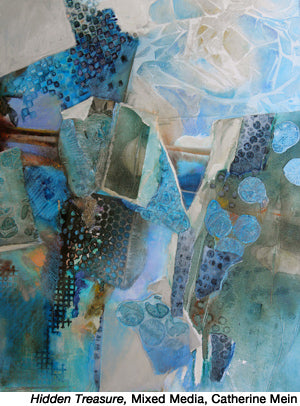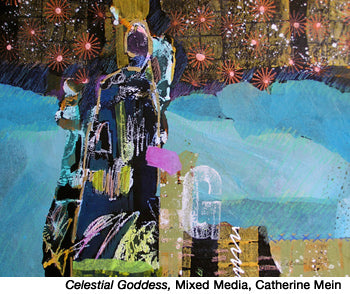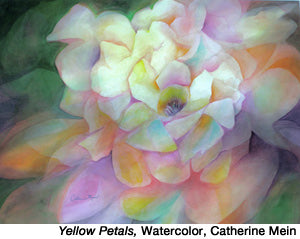News
Interview with Artist Catherine Mein
This interview is part of the Creative Catalyst Artist Interview Series and was originally published in 2012. 
Watercolor and mixed media artist Catherine Mein at first wasn't comfortable calling herself an artist. She had a checklist for what she had to accomplish before giving herself that title. But through years of practice and deep analysis of both her world and her work, she has developed a body of paintings that express through color relationships. subject matter, texture, movement and design the connection we have with each other and with the divine.
1. You started out in art school. What did art school teach you, and how did that translate into the real world of being an artist? What didn't art school prepare you for?
The years I spent in art school taught me to be more creative and assertive. It opened me up to the fact that there is a whole world out there full of options, possibilities and avenues of expression and that there is a large community of people who share their passion and talents with each other. I learned that there are teachers who can support you in your development as an artist. I realized that each one of us is unique, but we all share a common goal of expression and creativity.
Art school didn't prepare me for the nuts and bolt of the business world. They didn't cover such things as how to get your work out there, develop a web site, approach advertising, and be sure you have a strong body of work. It was a platform though that launched me in the right direction. Art school helped create the foundation that allowed me to develop into a more mature artist.
2. Your bio says you've studied extensively with national teachers. How do you choose which teachers you study with? What do you look for in a teacher? Is it their style? Their philosophy?
After art school, I knew I wanted to start with a spiritual foundation. The medium wasn't as important as the principle of studying art on a spiritual level. I studied for ten years with a teacher who taught the Laws of Color and how they appear in the atmosphere. This method was based on a watercolor painting technique practiced in a very specific way based on the observations of nature from Goethe and the spiritual concepts of Steiner, resulting in the style of spiritual painting found in the art of Liane Collot dʼHerbois. This method of painting liberates the artist to express their own point of view only as the final step in the process. I then wanted to learn from other teachers many other methods that focused on working with watercolor, acrylic, and oil painting. I relished the chance to learn more deeply the many aspects of painting from talented and gifted teachers and benefit from experiencing their own personal methods of expression. Studying with national teachers has been a very important aspect of my development as an artist.
 3. After a workshop, how do you incorporate what you've learned and fold it into your own style and work? Before I take a teacherʼs class, I learn all I can about the teacher by buying their DVDs and books and studying their work before I ever reach the classroom. I also set goals for myself on how I could get the most from my experience and try a little harder each time. I am very dedicated to taking copious notes of what the teacher is sharing. I like to take photographs of their process and end products so I can review them later. At first, I directly try aspects of what they are teaching in order to better familiarize myself with their techniques and to make sure that I know I can do it. Then I step back and analyze my own experience with the work, examine my strengths and weaknesses and determine what I want to accomplish with it. For me, it's about developing tools for getting across a spiritually significant message using the strengths that I naturally possess. The goal is to have not only a physical relationship with a painting but also an emotional and spiritual one, and through the process to invite the viewer into my world.
3. After a workshop, how do you incorporate what you've learned and fold it into your own style and work? Before I take a teacherʼs class, I learn all I can about the teacher by buying their DVDs and books and studying their work before I ever reach the classroom. I also set goals for myself on how I could get the most from my experience and try a little harder each time. I am very dedicated to taking copious notes of what the teacher is sharing. I like to take photographs of their process and end products so I can review them later. At first, I directly try aspects of what they are teaching in order to better familiarize myself with their techniques and to make sure that I know I can do it. Then I step back and analyze my own experience with the work, examine my strengths and weaknesses and determine what I want to accomplish with it. For me, it's about developing tools for getting across a spiritually significant message using the strengths that I naturally possess. The goal is to have not only a physical relationship with a painting but also an emotional and spiritual one, and through the process to invite the viewer into my world.
4. You work in very different styles of watercolor and collage. How is your approach different between these two? Is what your trying say different? Do the two media lend themselves to different types of expression and if so how?
While my body of work has pieces that can be quite different from each other, I hope that the spiritual emphasis, whether seen and interpreted by the human eye or felt by the heart, is one and the same. The different styles are not as important as the intention of the message- the consciousness of something greater than ourselves. We are part of a divine thread that holds us and connects us. I am trying to express this idea through the relationships of color, subject matter, texture, movement, and design in my pieces. All art conveys meaning, whether consciously or unconsciously. I see my body of work as reflecting my own evolution and interpretation of the divine in my life, as experienced through my intuition, thoughts, actions, and emotions. In both my watercolor and abstract paintings, I have tried to develop an eye for working and seeing things in an abstract way.
 5. How do you approach your abstract pieces? Do you make all your papers before hand and then pull the ones you need, or do you create the papers in the moment you're working one the piece? How long do your abstracts generally take? There are many methods I employ when I start an abstract painting. I can start very freely by exploring the colors and my emotions in loose and free strokes. At other times I pre-plan my ideas as I did in the Transformation in Time Series and pick out all my papers ahead of time before deciding how to use them. As another example, I recently had a one woman show where I first created thumbnail sketches by painting many different textures and patterns on penny papers rolls that you get at a bank. I knew I wanted to present the concept of Ancient Voices and their wisdom, so I played with different color combinations and textures to achieve my interpretation of this. I wrote my “recipes” down as I completed each sample painting and stapled it to the penny paper. I next painted on white tissue papers with fluid acrylics recreating my favorite penny papers. Tearing and cutting these sheets into various sizes, I then applied them to 300# cold pressed watercolor paper before finally drawing and painting again on top as a final layer. Working in this way was a wonderful discovery for me and I found I could complete a painting in a day or two.
5. How do you approach your abstract pieces? Do you make all your papers before hand and then pull the ones you need, or do you create the papers in the moment you're working one the piece? How long do your abstracts generally take? There are many methods I employ when I start an abstract painting. I can start very freely by exploring the colors and my emotions in loose and free strokes. At other times I pre-plan my ideas as I did in the Transformation in Time Series and pick out all my papers ahead of time before deciding how to use them. As another example, I recently had a one woman show where I first created thumbnail sketches by painting many different textures and patterns on penny papers rolls that you get at a bank. I knew I wanted to present the concept of Ancient Voices and their wisdom, so I played with different color combinations and textures to achieve my interpretation of this. I wrote my “recipes” down as I completed each sample painting and stapled it to the penny paper. I next painted on white tissue papers with fluid acrylics recreating my favorite penny papers. Tearing and cutting these sheets into various sizes, I then applied them to 300# cold pressed watercolor paper before finally drawing and painting again on top as a final layer. Working in this way was a wonderful discovery for me and I found I could complete a painting in a day or two.
6. Could you walk us through your process for your watercolor paintings? Do you do thumbnails or value studies before you start on the watercolor paper?
 To create a watercolor veil painting, I begin by knowing the relationship between light and darkness as it might occur as the sun is setting and then paint the colors that would appear in the atmosphere emulating the movement each color makes. At times, I have initially done a wet on wet value study using only black and grays to gain a better clarity of the movement of the piece. In the process of veil painting, one starts with bowls of diluted watercolor paint and a 1ʼʼ brush. Over a period of time lasting up to two weeks, I apply thirty to forty veils or glazes of paint progressively applying less paint as I go. Going through this process, I have learned a lot about color, while spending hours painting and living in the mystery of the unseen waiting for a form to emerge. You canʼt help but develop patience and a relationship to the inner work that is also going on. After applying the laws of color manifesting in the atmosphere, the last quarter of the painting is where I express myself in the work by creating forms.
To create a watercolor veil painting, I begin by knowing the relationship between light and darkness as it might occur as the sun is setting and then paint the colors that would appear in the atmosphere emulating the movement each color makes. At times, I have initially done a wet on wet value study using only black and grays to gain a better clarity of the movement of the piece. In the process of veil painting, one starts with bowls of diluted watercolor paint and a 1ʼʼ brush. Over a period of time lasting up to two weeks, I apply thirty to forty veils or glazes of paint progressively applying less paint as I go. Going through this process, I have learned a lot about color, while spending hours painting and living in the mystery of the unseen waiting for a form to emerge. You canʼt help but develop patience and a relationship to the inner work that is also going on. After applying the laws of color manifesting in the atmosphere, the last quarter of the painting is where I express myself in the work by creating forms.
7. In addition to working on paintings, are there specific skills you work on daily or weekly? Why? And why is that important?
I try to meditate consistently. I strive to spiritually develop as a person and become more of aware of myself and others. I love to work in my journal books putting down my thoughts, pasting in photographs, painting in color combinations I love, and gathering beautiful quotes that inspire me. I am both a life-long student and teacher, always observing and gathering information in my environment and loving life in all its interesting and diverse ways. Its important to me in all of this to stay connected to my central core from where I want to work.
8. All artists go through skill stages of beginning to intermediate to advanced. How did you push yourself to cross those? How did you know when you had passed into a next level? Were there different skills you think people should focus on at each level?
When I started painting, I felt insecure and didn't really consider myself an artist. I had my own checklist of what I needed to do to call myself an artist comfortably. I think time, maturity, experience, discipline, and a heart for painting each played a part in finally reaching this goal. I feel my paintings are now achieving a higher level of expression and confidence through my brushstrokes, color combinations, subject matter, volume of work, and quality of the end product.  The speed at which I work is faster, and I have so many more ideas and pathways to resolve challenges that I encounter than I ever had before. I have had an incredible wealth of teachers who have become friends who have helped me along the way. Each level of learning brings its challenges and rewards. In the beginning, we often only scratch the surface, and itʼs great to just spend time exploring as much as you want. As Iʼve evolved into a more experienced artist, I work larger, try more things, and do them well. I also can generate more solutions for the challenges I encounter. Being comfortable in my own skin now is a good sign for me as I continue to enjoy the act of creating.
The speed at which I work is faster, and I have so many more ideas and pathways to resolve challenges that I encounter than I ever had before. I have had an incredible wealth of teachers who have become friends who have helped me along the way. Each level of learning brings its challenges and rewards. In the beginning, we often only scratch the surface, and itʼs great to just spend time exploring as much as you want. As Iʼve evolved into a more experienced artist, I work larger, try more things, and do them well. I also can generate more solutions for the challenges I encounter. Being comfortable in my own skin now is a good sign for me as I continue to enjoy the act of creating.
To learn more about Catherine Mein and her work, visit her website, www.catherinemein.com.
Daily Painting: Reflecting on 31 Days
Image notes: Least favorite dog of the set, but I love that background, and I learned a technique I will use again.
Thirty-one days sort of. First some math, if I count today's, I did 24 paintings in the last month. Which if we're counting is 22 more paintings than I posted in February. I’m pretty sure I painted more than I posted, but how will we ever know?
The painting a day is a fascinating exercise. It was challenging and rewarding in totally unexpected ways.
The Pros:
Day 26- Daily Dog
This is my last dog for a few days while I get my wisdom teeth out. (Yay?) See you Sunday! (Or maybe Monday. But I promise to make up the missed 3-4 days. :)
Day 23- Daily Dog
It's always so fascinating to step back and look at a painting through the eye of a camera. So sure, I bring it into Photoshop and do my best to make sure the image on screen matches hue and value to the one in front of me on the canvas, but there is somethign about seeing it by itself. How that one step of removal can show you all sorts of things you hadn't noticed before. How that nose needs more red. How the left jowl pushes forward and needs to be pushed back. How I finally got the color of blue I'd been trying to get for a few weeks (cobalt and burnt umber for the win!)
This probably counts as my first layer. Now time to put it away and think about all of those components. Shelf the pluses and the negatives and then come back to it again another day with fresh eyes.
Day 22- Daily (Problem) Dog
One of the reasons why I love painting is because I love the mental challenge of painting. This can of course be a tightrope between a growth experience and a very frustrating experience. Often both simultaneously.
Abstract artist Virginia Cobb says that she likes to set up problems in her paintings so that she forces herself to find solutions. I didn't truly understand that until the past few months of painting. Problem paintings can turn out to be the best paintings. Maybe not visually but artistically. Because at some point if you've worked a painting too hard or too long, you get to a point where you don't have to be careful any longer. There's nothing left to protect. And when there is nothing left to protect, you can really start learning something.





